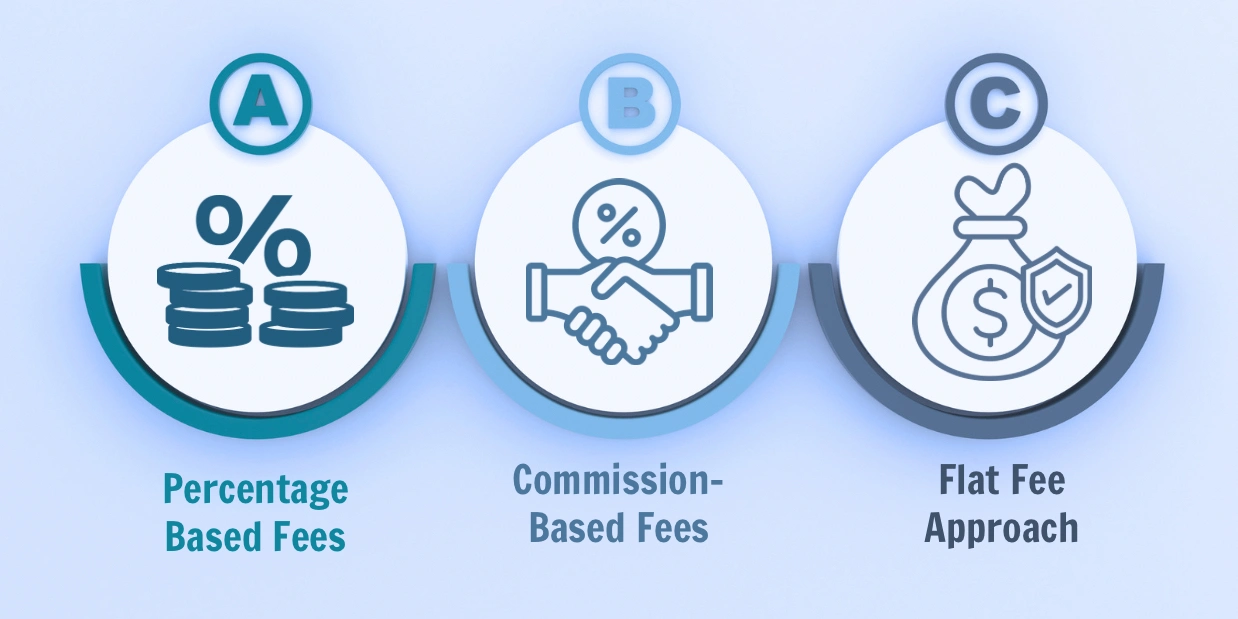Are you puzzled about the cost of hiring a financial advisor? You’re not alone. Many people are unaware that fee-only advisor planning is an option that can save thousands, compared to traditional pricing models.
This blog post will help you understand how this innovative approach works, and provide tips for finding the right flat-fee financial advisor for you. Ready to simplify your financial future? Let’s dive in!
Key takeaways
●fee-only advisor planning allows you to pay a set price for services, regardless of your account balance.
●This pricing model can potentially save you money compared to fee-only, as your cost stays the same even if your investments grow in value.
●While flat-fee financial advisor planning offers transparency and potential savings, it may have limitations on personalized investment advice. It's important to consider your individual circumstances before choosing this approach.
●When selecting a flat fee financial advisor, consider the offered services, compare costs, and check their reputation.
Understanding Flat Fee Financial Advisors Planning
Fee-only Advisors planning is becoming more popular. It means you pay a set price for services. This fee doesn’t change, no matter how big or small your account balance is. A fee-only financial advisor charges this way.
The price can range from $1,000 to $10,000 per year or more. The amount depends on things like income and portfolio size. Financial advisors are starting to use this payment model.
Clients could save lots of money with a flat fee setup.
The Financial Advisor might offer just financial planning help. Or they may give both investment management advice and planning guidance together.
This comprehensive approach ensures that not only your financial strategy is well-crafted, but your investments are also strategically managed to align with your goals.
The billing usually happens four times a year and lasts many years for some clients. This structure ensures ongoing support and monitoring, including investment management adjustments as needed.
In the realm of financial services, the concept of fee-only advisor planning has gained substantial prominence. This approach enables individuals to engage the expertise of a professional advisor without being subjected to fluctuating fees tied to account balances.
With a fixed fee structure, clients have the advantage of knowing exactly what they’ll pay upfront, avoiding any surprises down the line.
This level of transparency not only provides peace of mind but also encourages individuals to seek professional financial guidance without hesitation, regardless of whether they’re looking to invest tens of thousands or manage a more modest portfolio.
By embracing a flat fee arrangement, clients can access personalized advice, navigate various investment options, and even explore strategies involving hedge funds, all while maintaining control over the costs they pay for these invaluable services.
In the modern financial landscape, the benefits of fee-only advisor planning extend beyond just cost predictability.
Clients have the flexibility to pay a fixed fee for services that cater to their unique needs, whether it’s retirement planning, investment management, or comprehensive financial guidance.
This model democratizes financial advice, making it accessible to a wide range of individuals who may be deterred by the complex fee structures associated with traditional advisory services.
Whether clients are working with a substantial sum or are managing more modest assets, the flat fee approach ensures that they receive expert guidance without the worry of excessive fees.
This innovative approach aligns the interests of both clients and advisors, creating a win-win scenario where individuals can confidently pursue their financial goals while advisors can provide expert assistance without compromise.
- Cost Predictability
- Comprehensive Services
- Personalized Advice
- Ongoing Support
- Accessibility
- Limited Investment Options
- High Costs for Small Portfolios
- Service Scope
- Potential for Bias
- Lack of Performance Incentives
The Pros and Cons of Flat Fee Financial Advisors Planning
Flat-fee financial Advisors’ planning offers potential savings and transparency in cost, but it may lack personalization.

Potential for Savings
Flat-fee financial planning with a qualified financial planner can save you a lot of money. If your financial advisor charges a percentage of the assets they manage, it might end up costing you more over time than flat fees.
For example, a certified financial planner may take 1% of each part of the money they handle for you. This could translate to thousands of dollars in fees every year! On the other hand, by opting for a flat fee plan with a skilled financial planner, your costs remain consistent, regardless of how much your wealth grows.
This type of financial planning approach is especially beneficial if your net worth experiences significant growth over time. In contrast, with other fee structures, the amount you pay tends to rise in tandem with the increasing value of your investments.
The beauty of the flat fee model is that it remains unchanged even when the markets are performing well. By embracing this approach, customers regain control over their financial journey and maintain stable costs, even during periods of financial prosperity.
Transparency in cost
You always know what you pay with a flat fee financial advisor. The cost does not change or go up due to the stock market or more money in your account. This clear cost helps you plan for the fees every year without any bad surprises.
It’s fair for both the client and advisor, making it a good choice for many people looking for help with their money plans.
Potential lack of personalization
Flat-fee financial advisor planning may come with a potential drawback, which is the potential lack of personalization.
This means that since you’re paying a fixed fee for the services, there may be limitations on how tailored the advice and recommendations are to your individual circumstances.
Personalized financial planning takes into account factors such as your income, net worth, investment management goals, and risk tolerance.
However, with a flat fee model, there may not be as much opportunity for in-depth analysis or customization to meet your specific needs.
It’s important to consider this aspect when deciding if flat-fee financial Advisors planning is right for you.
Comparison of Fee Structures
There are various fee structures for financial advisors, including fee-only, commission-based fees, and the flat fee approach. To learn more about these different options and how they compare, read on.

Percentage Based Fees
Financial advisors often charge a percentage of the assets they manage as their fee. This means that the more money you have invested, the higher your advisor’s fees will be.
However, this can potentially cost clients more compared to other fee structures like flat fees. The percentage charged by an advisor may vary based on factors such as income, portfolio size, and individual circumstances.
It’s important to note that market fluctuations and account additions can also affect the amount you pay in fees only. Some people find this fee structure less transparent compared to flat fees because it’s not always clear how much you’re actually paying for their services.
Commission-Based Fees
Commission-based fees are another type of fee structure that some financial advisors use. With this model, the advisor earns a commission on financial products they sell to clients.
This means that their compensation is tied to the sale of these products, such as annuities or mutual funds.
While this may seem convenient for clients who don’t have to pay upfront fees, it’s important to be aware of potential conflicts of interest.
Advisors may prioritize selling products that earn them higher commissions, rather than selecting investment management solely based on what is best for their clients.
Commission-based fees can also result in hidden costs and possible surrender charges if you need to make changes or withdraw your money early from certain investments.
Flat Fee Approach
A flat fee approach is a pricing model used by some financial advisors where clients pay a set fee for their services, regardless of the size of their investment management portfolio. This can be an attractive option for individuals who want transparency in cost and potential savings.
By paying a flat fee, clients may avoid the percentage trap and save thousands of dollars each year compared to advisors who charge a percentage-based fee.
The amount of the flat fee may depend on factors such as income, portfolio size, and the complexity of an individual’s circumstances.
It’s important to carefully consider what services are included in the flat fee arrangement before choosing a financial advisor with this approach. While the flat fee approach offers advantages, potential conflicts of interest can arise.
Advisors might be motivated to take on more clients, affecting personalized attention. Additionally, advisors might recommend fee-generating products.
Fee-only planners typically have fewer conflicts of interest, focus on advice, and can offer flexible payment models.
Advisors who are fee-only generally put their clients’ interests first and, thus carry a fiduciary responsibility because there are no commissions. The fiduciary standard of care requires that a financial advisor act solely in the client’s best interest when offering personalized financial advice.
By hiring a fee-only fiduciary investment advisor to manage your investments, develop a financial plan, or both, you are assured you alone are paying a financial professional who is legally and professionally committed to acting in your best interests.
To navigate this, transparent communication is key. Discuss potential conflicts with your advisor and ensure recommendations align with your goals.
Prioritize advisors with ethical standards and a commitment to your financial well-being to mitigate conflicts and foster a trustworthy relationship.
Services Included in Flat Fee Financial Advisors Planning
Flat-fee financial advisors planning services typically offer a range of services to clients. These may include:
- Developing a comprehensive financial plan tailored to the client’s goals and circumstances
- Providing investment management advisory services, including portfolio management and asset allocation strategies
- Assisting with retirement planning, such as determining optimal savings rates and estimating future income needs
- Offering tax planning advice to minimize tax liabilities and maximize deductions
- Providing guidance on estate planning, including creating wills, trusts, and powers of attorney
- Helping clients with budgeting and cash flow management to achieve their financial goals
- Offering guidance on insurance needs, such as life insurance or long-term care insurance
- Assisting with education funding strategies for college savings plans or student loan repayment options
In case of any potential conflict of interest, the insurance products are the safest option for the advisor whom you can also consult at an hourly rate and find out the trending investment products by speaking to other advisors and then choose the product that matches most advisors interest and increases your asset levels as maintaining your asset levels are equally important that too by paying less money and gaining more profits.
How to Choose the Right Flat Fee Financial Advisor
When choosing a flat-fee financial advisor, it is important to carefully consider the services, compare costs, and check the advisor’s reputation.
Choosing the right flat-fee financial advisor is a critical decision that can significantly impact your financial journey. With the proliferation of advisory services, it’s essential to navigate the wealth management landscape with care.
Flat-fee advisors offer a transparent pricing structure that can be particularly appealing. When selecting an advisor, consider their expertise in wealth management, as this will shape your financial future.

Assessing Services and Expertise
Firstly, evaluate the scope of interest by different advisors. Look for those who emphasize comprehensive wealth management, encompassing investment strategies, financial products, estate planning, and more.
By opting for a flat fee advisor with a broad spectrum of services, you ensure holistic financial care that addresses your evolving needs.
Secondly, delve into the advisory fees associated with each flat fee advisor. Transparency is key here. Reputable advisors should clearly outline their fees and any potential additional costs.
Compare these fees across advisors to determine which offers the best value while still aligning with your budget. When considering flat fee advisors, be attentive to any assets under management (AUM) fees.
Some advisors charge a percentage of your portfolio’s value as part of their wealth management approach. Understanding how AUM fees may impact your overall returns is vital in making an informed decision.
- Diverse Expertise
- Holistic Care
- Transparent Costs
- Budget Alignment
- Returns Awareness
- Time Intensive
- Complex Fees
- Neglecting Other Factors
- Misaligned Services
- Undisclosed Impact
Transparency in Fees and Costs
Wealth management extends beyond mere financial planning; it’s about cultivating a relationship with an advisor who understands your goals and risk tolerance.
Seek out advisors who prioritize open communication and regular reviews of your financial plan. A strong wealth management strategy requires ongoing adjustments to stay in sync with your evolving circumstances.
Furthermore, research the track record and credentials of potential advisors. Reviews, testimonials, and professional affiliations can shed light on their competence in wealth management.
Look for advisors who have demonstrated success in helping clients achieve their financial objectives.
Most Financial advisors charge flat fees and many financial advisors have a fixed fee process as it depends on the fee model that they are following for the best interest without the conflicts of interest in the pay of advisors so that you can choose to be billed quarterly or with aum fee or out of the goodness of the heart of the advisor provide advice for completely free or in exchange commission.
In the financial industry, whether you select hedge funds, rental property income, capital gains, Garrett planning network, or any other product or plan suggested by the advisor, you will have to pay an aum fee, or be billed quarterly or a fixed fee depending on their fee model but you need to make that clear for yourself first.
Building a Strong Advisor-Client Relationship
In the process of selecting the right flat fee financial advisor, meticulous attention to the wealth management services they offer is crucial. It’s essential to assess not only their comprehensive offerings but also their advisory fees and the potential impact of AUM fees.
A vital component of effective wealth management is the establishment of a dynamic relationship between the advisor and the client. Therefore, prioritize advisors who place great importance on maintaining ongoing communication to ensure that your financial interests remain aligned with your evolving goals.
By carefully choosing a seasoned flat fee advisor with a proven track record, you empower yourself to confidently navigate the path toward securing your financial well-being while fostering a strong advisor-client partnership.
Robot Advisors: Enhancing Financial Planning Through Automation In the realm of modern financial planning, advisors, also known as automated digital fee-based platforms, have emerged as revolutionary tools. These platforms harness the power of algorithms to provide clients with algorithm-driven financial planning and investment management services.
This innovative approach has captured the interest of many investors seeking efficient and cost-effective solutions. Robo-advisors offer the opportunity to access professional financial guidance without the need for extensive social security information, making the process streamlined and accessible.
These platforms aim to optimize investment strategies, making them suitable for clients with diverse financial interests.
While social security considerations may vary, the convenience and automated precision of advisor make them a compelling option for those looking to enhance their financial planning and management endeavors.
Consider the services offered
When choosing a flat-fee financial advisor, it’s important to consider the services they offer. Some advisors may only provide a financial plan, while others also offer investment management advisory services.
It’s crucial to understand what is included in the fee and determine if their services align with your needs. For example, if you require ongoing investment management and planning for retirement, you’ll want to find an advisor who offers these services as part of their flat fee package.
Additionally, some advisors may specialize in certain areas such as taxes or estate planning, so be sure to choose one that can address your specific financial goals.
By carefully considering the interests of different fee-only advisors, you can find the right advisor who can meet your unique needs.
Compare costs
When evaluating the costs associated with a flat fee financial advisor, a fee-only charge for the best interest should hold a central place in your considerations.
A reputable flat fee advisor can guide you through the intricacies of retirement planning not once, but multiple times over the years, ensuring your financial goals remain on track.
As you delve into the details of various advisors, make sure that their services encompass comprehensive financial plans that encompass not only immediate financial concerns but also long-term retirement aspirations.
The financial advisor may inform you about the aum fees as well as the comprehensive financial plan to help you gain maximum profits over your investments and charge flat fees for the same.
It’s prudent to remember that the expenses tied to a flat fee advisor are not fixed and can range from $1,000 to $10,000 or even higher annually. As you weigh your options, keep in mind that these figures can greatly influence the quality of your retirement planning.
Opting for a flat fee advisor who specializes in comprehensive financial plans can lead to a smoother retirement journey, aligning your portfolio size and individual circumstances with tailored strategies.
To make an informed decision, engage in thorough research to compare the offerings of different advisors. Gauge their proficiency in the planning network by assessing their track record and ensuring they offer services that go beyond surface-level advice.
By selecting a flat fee advisor that prioritizes retirement planning and provides comprehensive financial plans, you can strike a balance between competitive pricing and securing a prosperous financial future.
Check the advisor's reputation
Before entrusting your financial future to a flat fee financial advisor, it’s crucial to thoroughly assess their reputation. You want to ensure that the advisor not only offers a flat fee structure but also has a proven track record of providing dependable and credible financial planning services.
One effective approach to gauge their reputation is to delve into client reviews and testimonials. These firsthand accounts can offer insights into the experiences of others who have benefited from the financial planning advisor’s services.
Reading about how their financial planning strategies have positively impacted various clients can provide valuable context. Furthermore, it’s essential to scrutinize the advisor’s credentials and qualifications.
Make sure they possess the necessary expertise to not only manage your finances effectively but also to tailor financial planning strategies that align with your goals. Their education, certifications, and experience are indicators of their competence in the realm of financial planning.
Seeking recommendations from trusted sources, such as close friends or family members, who have collaborated with the advisor before can provide you with additional confidence in your decision.
Their personal accounts can shed light on the strengths and qualities of the financial planning advisor. Lastly, be diligent in checking for any potential red flags.
Investigate if there have been any disciplinary actions or complaints filed against the advisor. This information can help you avoid potential pitfalls and ensure that your financial planning journey is in safe and capable hands.
Remember, the success of your financial planning endeavors greatly hinges on the reputation and trustworthiness of the advisor you choose. By conducting thorough research and assessment, you can make an informed decision and embark on your financial journey with confidence.
The Impact of Financial Advisor’s Fee Structure on Your Investments
The fee structure of a financial advisor can have a significant impact on your investments. One key factor to consider is the potential for savings. Flat-fee financial advisors planning arrangements can save clients thousands of dollars in annual fees each year compared to advisors who are paid a percentage of the assets they manage.
This means that more money stays in your investment management accounts, allowing for greater growth over time, all while avoiding the burden of high annual fees.
Transparency in cost is another advantage of flat-fee financial advisors’ planning. With a flat fee, you know exactly how much you will be charged upfront in annual fees, making it easier to budget and plan for your financial goals with a clear understanding of your costs.
In contrast, fees only can be variable and may increase as your portfolio grows, leading to unpredictable annual fee amounts that can impact your investment returns.
However, it’s important to also consider the potential lack of personalization with flat-fee financial advisors planning. Since the fee remains constant regardless of the complexity or effort required, some investors may feel that their individual circumstances and needs are not fully taken into account within the scope of the annual fee structure.
It’s important to find a balance between the cost-saving benefits, the clarity of annual fees, and personalized advice when choosing a financial advisor for your investment management journey.
It is important to understand the annual fee and the fee-only financial advisors shall be generating through the process. The personal financial advisors may help you gain a view about your investment account keeping in mind the aum fees that we will be incurring through the comprehensive financial advice and the flat annual fee because that may influence our vision in various ways.
The fee-only financial advisors charge
Conclusion
In conclusion, flat-fee financial advisors planning offers a transparent and cost-effective alternative to traditional pricing models. It allows clients to save money and have control over their fees.
The Flat annual fee also prepares you for planning your ongoing investment management in an efficient manner, in some cases to also benefit your retirement planning and comprehensive financial plan.
The fee-only national association charges aum fees keeping in mind the best interest of the client’s purchase and fee only is also charged while selling financial products.
However, it’s important to carefully consider the services offered and compare costs before choosing a flat-fee financial advisor. Overall, the flat fee approach provides simplicity and transparency in managing your finances.
FAQs
fee-only advisor planning is a service where a financial planner charges a fixed, upfront fee for providing comprehensive financial advice and guidance, regardless of the client’s assets or income.
Unlike traditional commission-based services, which earn money through product sales or transactions, flat-fee financial planners charge a set fee for their expertise and time, ensuring unbiased advice that aligns with the client’s best interests.
Yes, anyone can benefit from fee-only advisor planning as it offers personalized guidance tailored to an individual’s unique goals and circumstances. It ensures access to professional advice without being dependent on the size of one’s wealth.
The cost of fee-only advisor planning varies depending on the complexity of an individual’s finances and the services provided by the planner. However, it typically ranges from several hundred to several thousand dollars.








